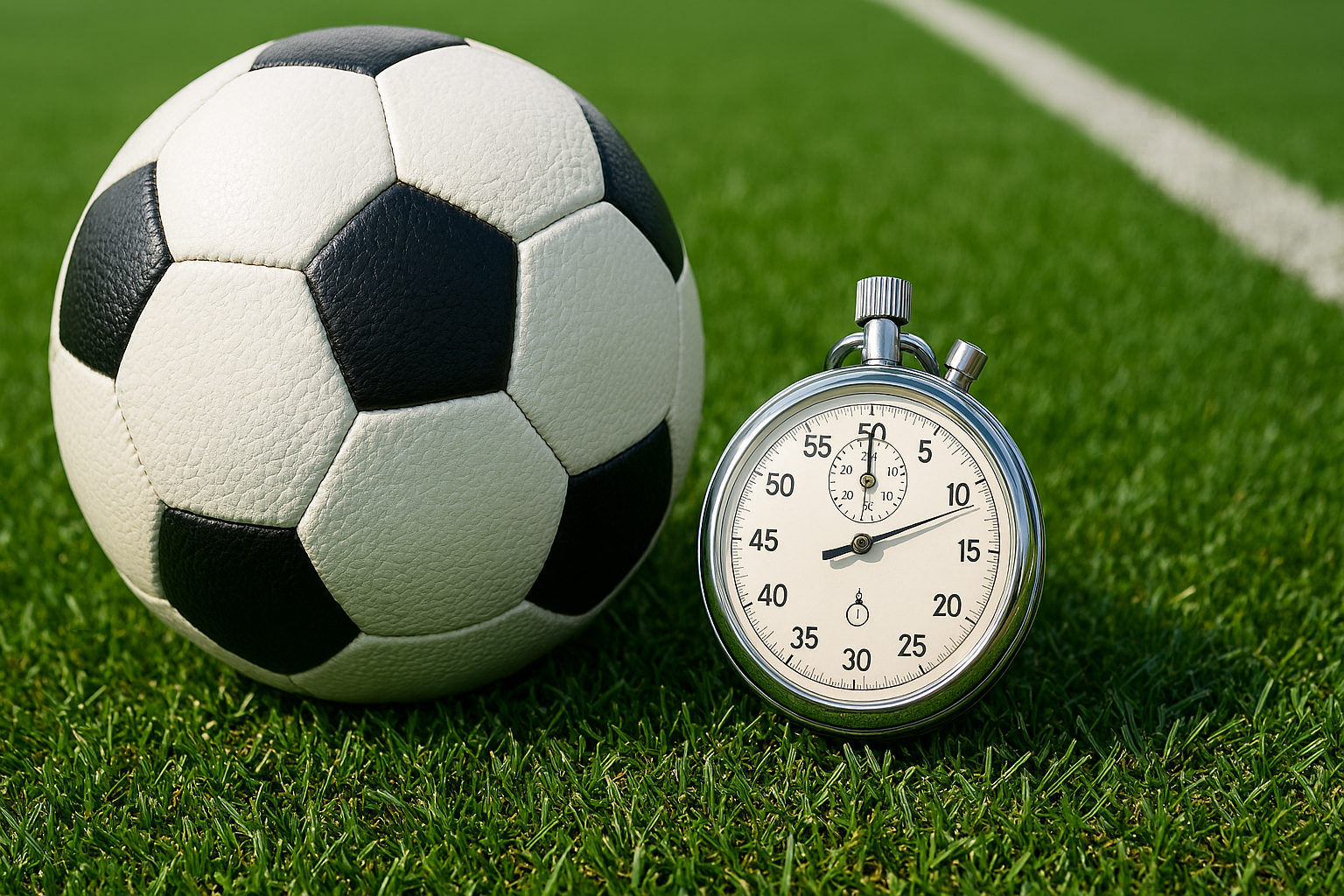
Understanding the duration of a football game is essential for fans planning their viewing experience, coaches managing team schedules, and anyone involved in event planning around America’s most popular sport. While the official game clock shows 60 minutes of play time, the reality is far more complex and varies significantly across different levels of football.
The confusion around football game length stems from the fundamental difference between game time and real time. When someone asks “how long is a football game,” they might be referring to the official playing time, the actual time spent watching, or the total time commitment including pre-game activities. This comprehensive guide will break down every aspect of football game duration, from youth leagues to the NFL, helping you understand exactly what to expect when you tune in or show up to the stadium.
Understanding the Basics of Football Game Duration
The Official Length of a Football Game
Football games are officially structured around 60 minutes of playing time, divided into four 15-minute quarters. However, this standard applies primarily to professional and college levels, with variations occurring at high school and youth levels.
Standard Game Structure:
- NFL: Four 15-minute quarters (60 minutes total)
- College Football: Four 15-minute quarters (60 minutes total)
- High School: Four 12-minute quarters (48 minutes total)
- Youth Leagues: Varies from 8-12 minute quarters depending on age group
The halftime break provides additional structure to the game, typically lasting 12 minutes in the NFL, 20 minutes in college football, and 15-20 minutes at the high school level. These official time periods represent just the foundation of actual game duration.
Game Clock vs. Real-Time Duration
The most important concept to understand is that the game clock and real-time duration are completely different measurements. The 60-minute game clock only runs during active play, stopping frequently for various reasons throughout the game.
Clock Stoppage Situations:
- Incomplete passes
- Players going out of bounds
- Timeouts (team and official)
- Penalties and their enforcement
- Injury timeouts
- Two-minute warnings (NFL only)
- Scoring plays and extra points
- Change of possession
- Replay reviews
These frequent stoppages mean that a 60-minute game stretches to 3+ hours in real time. The NFL averages approximately 3 hours and 12 minutes per game, while college football games average 3 hours and 24 minutes. High school games typically run 2 to 2.5 hours due to shorter quarters and fewer commercial breaks.
Factors That Influence How Long a Football Game Lasts
Game Structure and Rules Variations
Different levels of football employ varying rules that directly impact game duration. The NFL’s two-minute warning, for instance, adds an automatic timeout late in each half, extending the game’s length. College football’s clock management rules differ significantly from the NFL, particularly regarding first downs and out-of-bounds plays.
Key Rule Differences:
- College football stops the clock on first downs until the chains are set
- NFL runs a continuous clock except in specific situations
- High school football may use a running clock in blowout situations
- Overtime procedures vary dramatically between levels
Overtime rules create the most significant variations in game length. NFL games can theoretically continue indefinitely in the playoffs, though regular season games can end in ties after one overtime period. College football’s current playoff format can lead to extended multiple-overtime games, while high school overtime typically uses shortened procedures to minimize game length.
Game Flow and Style of Play
The style of play adopted by teams significantly influences game duration. Pass-heavy offenses naturally extend games because incomplete passes stop the clock, while run-heavy teams help games conclude more quickly since most running plays keep the clock moving.
Teams that frequently throw the ball, particularly those employing no-huddle or hurry-up offenses, create more clock stoppages but also run more plays per game. Conversely, teams that emphasize ball control and ground games typically participate in shorter real-time contests.
Play Style Impact:
- High-passing offenses: Longer real-time duration
- Running-focused teams: Shorter real-time duration
- No-huddle offenses: More plays, potentially longer games
- Ball-control strategies: Fewer clock stoppages, shorter games
Broadcasting and Commercial Influence
Television broadcasts significantly extend game duration through commercial breaks, replay reviews, and enhanced production elements. Nationally televised games typically run 15-30 minutes longer than non-televised contests due to additional commercial commitments and extended halftime shows.
The NFL has specific television timeout requirements that add approximately 20 minutes to each game’s duration. College football broadcasts often include even more extensive commercial breaks, particularly during high-profile matchups and bowl games.
Broadcasting Extensions:
- Television timeouts: 6-8 per half in NFL games
- Enhanced replay reviews for televised games
- Extended halftime presentations
- Post-touchdown and pre-kickoff commercial breaks
- Network promotional segments
Weather and External Conditions
Weather-related delays can dramatically extend football games beyond their typical duration. Lightning delays, in particular, can add hours to a game’s total time, as safety protocols require players and spectators to seek shelter until the threat passes.
Extreme weather conditions like heavy snow, ice, or dangerous heat can also slow game pace and create additional delays. Some of the longest games in football history resulted from weather delays rather than competitive factors.
Variations by Level and League
NFL Games
Professional football games represent the most standardized timing format in American football. The NFL’s 60-minute game structure, combined with extensive commercial obligations, creates the most predictable yet lengthy viewing experience.
NFL Game Timing Breakdown:
- Regulation time: 60 minutes (game clock)
- Real-time average: 3 hours and 12 minutes
- Halftime: 12 minutes (up to 30 minutes for Super Bowl)
- Television timeouts: Approximately 20 minutes total
- Injury timeouts and reviews: Variable additional time
The Super Bowl represents the extreme end of NFL game duration, often exceeding 4 hours due to extended halftime shows, additional commercial breaks, and enhanced production value. Regular season games maintain more consistent timing, though prime-time games typically run longer than afternoon contests.
College Football
College football games traditionally run longer than NFL contests due to different clock management rules and extensive television coverage. The NCAA’s rule allowing the clock to stop on first downs creates additional game stoppages, while the college overtime format can extend games significantly.
College Football Characteristics:
- Average duration: 3 hours and 24 minutes
- Extended halftime shows at major games
- Multiple overtime periods without game-ending rules
- Longer television timeouts during marquee matchups
- Band performances and campus traditions adding time
Bowl games and playoff contests often exceed 4 hours due to enhanced pageantry, extended halftime shows, and the high-stakes nature creating more strategic clock management. The College Football Playoff National Championship regularly approaches or exceeds 4.5 hours of total viewing time.
High School Football
High school football offers the most efficient timing format, with 48-minute game clocks and fewer commercial interruptions creating a more streamlined experience. Friday night games typically conclude within 2.5 hours, making them more family-friendly for school night viewing.
High School Game Features:
- Four 12-minute quarters (48 total minutes)
- 15-20 minute halftime for band performances
- Limited replay review capabilities
- Running clock rules in lopsided games
- Average duration: 2 to 2.5 hours
The shorter quarter length and simplified overtime procedures help high school games maintain reasonable duration while still providing comprehensive football action. Many states employ mercy rules that implement running clocks when score differentials become excessive, further controlling game length.
Youth and Recreational Leagues
Youth football leagues prioritize participation and development over broadcasting concerns, creating the shortest game formats in organized football. Quarter lengths typically range from 8-12 minutes depending on age groups, with emphasis on getting all players meaningful participation time.
Youth League Adaptations:
- Shorter quarters based on age group
- Mandatory playing time rules
- Simplified overtime or elimination of ties
- Parent-friendly scheduling considerations
- Focus on skill development over game duration
These adaptations ensure that young players receive appropriate physical demands while maintaining family scheduling compatibility. Most youth games conclude within 1.5 to 2 hours, including pre-game warm-ups and post-game activities.
International Football Variations
American football leagues outside the United States often adapt timing rules to fit local broadcasting and cultural preferences. The Canadian Football League (CFL) maintains similar timing to the NFL but with three downs instead of four, potentially affecting game pace.
European and Asian leagues frequently experiment with shorter game formats to accommodate different sports cultures and broadcasting constraints. Some leagues employ 30-minute halves instead of four quarters, while others maintain American timing standards.
Comparing American Football to Other Sports
American Football vs. Soccer
The contrast between American football and soccer timing illustrates the fundamental differences in sport structure. Soccer matches consist of two 45-minute halves with minimal stoppages, creating a 90-minute game that typically concludes within 2 hours including halftime and injury time.
Football’s stop-and-start nature, combined with strategic timeouts and commercial breaks, extends the viewing experience significantly beyond soccer’s continuous play format. While soccer maintains constant action during play periods, football provides strategic depth through its start-stop structure.
American Football vs. Basketball and Baseball
NBA basketball games feature four 12-minute quarters but extend to approximately 2.5 hours due to timeouts, fouls, and commercial breaks. Baseball games have no time limit but average around 3 hours, similar to football but through different mechanisms.
Comparative Average Durations:
- NFL Football: 3 hours, 12 minutes
- College Football: 3 hours, 24 minutes
- MLB Baseball: 3 hours, 4 minutes
- NBA Basketball: 2 hours, 37 minutes
- NHL Hockey: 2 hours, 30 minutes
Rugby provides an interesting comparison as another physical contact sport, with 80-minute matches typically concluding within 2 hours due to continuous play similar to soccer.
The Experience of Watching a Football Game
Attending a Game in Person
Stadium attendance requires a significantly larger time commitment than television viewing. Successful game attendance typically involves arriving 1-2 hours early for parking, concessions, and pre-game atmosphere, followed by potential post-game traffic delays.
Stadium Time Commitment:
- Pre-game arrival: 1-2 hours early
- Game duration: 3+ hours
- Post-game departure: 30-60 minutes
- Total commitment: 5-6 hours for major games
Stadium experiences often include enhanced entertainment during television timeouts, band performances, and fan interaction activities that aren’t visible during broadcasts. These elements can make the extended duration feel more engaging for live attendees.
Many football fans utilize the game-day experience as social events, arriving early for tailgating and staying late for post-game celebrations. This social aspect transforms the time commitment into a valued recreational activity rather than simply a viewing obligation.
Watching on Television or Streaming
Television viewing offers more control over the football experience while maintaining the full game duration. Commercial breaks provide natural opportunities for household activities, while replay coverage often enhances understanding of complex plays.
Streaming services and DVR technology allow viewers to skip commercials and reduce total viewing time to approximately 2.5 hours for a complete game. However, many fans prefer live viewing to maintain the excitement and social media interaction that accompanies real-time football consumption.
Television Viewing Advantages:
- Multiple camera angles and instant replays
- Expert commentary and analysis
- Statistical information and graphics
- Climate-controlled comfort
- Food and beverage convenience
For fantasy football enthusiasts, television viewing provides access to multiple games simultaneously through RedZone coverage or multi-game packages, maximizing football consumption within the available time window. This relates to the growing popularity of fantasy football, where participants often seek funny fantasy football names to express their creativity and team personality while managing their rosters throughout the extended game durations.
Special Cases and Extended Games
Championship Game Extensions
Major championship games regularly exceed standard duration through enhanced production value and extended ceremonies. The Super Bowl routinely approaches or exceeds 4 hours due to elaborate halftime shows, additional commercial inventory, and ceremonial elements.
College football’s National Championship and major bowl games often feature extended pregame shows, longer halftime presentations, and additional television coverage that extends the total broadcast time significantly beyond regular season contests.
Championship Game Extensions:
- Super Bowl: 4+ hours typical duration
- College National Championship: 4-4.5 hours
- Conference championships: 3.5-4 hours
- High school state championships: 3-3.5 hours
These extensions reflect the cultural significance of championship games and the willingness of broadcasters and audiences to invest additional time in premier sporting events.
Marathon Overtime Games
Some football games achieve legendary status through extended overtime periods that push total duration to extreme lengths. The longest NFL game in history, a 1971 playoff contest between Miami and Kansas City, lasted 82 minutes and 40 seconds of game time spread over nearly 6 hours of real time.
College football’s overtime format creates even more potential for extended games, with some contests featuring 6, 7, or even more overtime periods. These marathon games become part of football folklore while demonstrating the sport’s capacity for dramatic, extended competition.
Recent rule changes in both professional and college football have aimed to reduce the likelihood of extremely long overtime games while maintaining competitive integrity. The NFL’s modified playoff overtime rules and college football’s revised overtime format both seek to balance excitement with practical duration concerns.
Historical and Statistical Insights
Evolution of Game Length Over Time
Football games have gradually increased in duration over the past several decades, primarily due to expanded television coverage and commercial integration. Games that concluded within 2.5 hours in the 1970s now regularly exceed 3 hours due to these broadcast enhancements.
Rule changes have generally added time rather than reduced it, with expanded replay review systems, additional timeout options, and enhanced safety protocols contributing to longer games. The introduction of the two-minute warning in the NFL specifically added time to accommodate television programming needs.
Historical Duration Trends:
- 1970s: Average NFL game approximately 2 hours, 45 minutes
- 1990s: Average duration increased to 3 hours, 5 minutes
- 2010s: Current average of 3 hours, 12 minutes established
- Future projections: Continued gradual increases likely
Longest and Shortest Games in History
Record-setting games provide context for the extreme ranges of football duration. The shortest NFL game on record lasted just 2 hours and 29 minutes during a 2009 contest between Tennessee and Houston, facilitated by minimal penalties, few incomplete passes, and efficient clock management.
Conversely, weather delays and multiple overtime periods have created games exceeding 7 hours of total time commitment. These extreme cases highlight the unpredictable nature of football duration and the importance of flexible scheduling for attendees and viewers.
Future of Football Game Duration
Proposed Rule Changes and Efficiency Improvements
Football organizations at all levels continuously evaluate rule modifications aimed at improving pace of play without compromising game quality. The NCAA has experimented with reduced halftime lengths, streamlined replay procedures, and modified clock management rules to address duration concerns.
The NFL has tested various timing modifications during preseason games, including reduced commercial break lengths, faster replay reviews, and alternative overtime formats. These experiments reflect ongoing efforts to balance television revenue, viewer engagement, and practical scheduling considerations.
Potential Future Modifications:
- Reduced commercial break frequency or duration
- Streamlined replay review processes
- Modified timeout rules and quantities
- Alternative overtime formats
- Enhanced pace-of-play incentives
Technology and Broadcasting Evolution
Advanced technology offers potential solutions for reducing game duration while enhancing viewer experience. Faster replay systems, automated officiating assistance, and improved communication systems could streamline various game delays.
Streaming platforms and on-demand viewing continue to change how audiences consume football content, potentially reducing pressure for live broadcast duration optimization. These technological advances might allow for more efficient game presentation while maintaining traditional game structure.
The integration of women football speaker 2025 events and educational programming around football games demonstrates the sport’s expanding cultural impact beyond just the game itself, as audiences seek comprehensive football experiences that include expert analysis and diverse perspectives on the game’s evolution.
Frequently Asked Questions About Football Game Duration
How long does an NFL game last in real time?
NFL games average 3 hours and 12 minutes in real time, despite having only 60 minutes on the game clock. This extension results from frequent clock stoppages, commercial breaks, halftime, and various game delays. Playoff games and nationally televised contests often run 15-30 minutes longer than this average.
Why does a 60-minute football game take 3+ hours?
The game clock only runs during active play, stopping frequently for incomplete passes, out-of-bounds plays, timeouts, penalties, and scoring plays. Additionally, commercial breaks, halftime shows, and replay reviews add significant time beyond the actual playing period. The result is that only about 11 minutes of actual ball-in-play action occurs during a typical NFL game.
How long is halftime in NFL and college football?
NFL halftime lasts 12 minutes for regular season games, extending to up to 30 minutes for the Super Bowl. College football halftime typically runs 20 minutes to accommodate band performances and campus traditions. High school games usually feature 15-20 minute halftimes, while youth leagues often use 10-15 minute breaks.
How long is the Super Bowl compared to a regular NFL game?
The Super Bowl typically runs 4+ hours compared to the regular season average of 3 hours and 12 minutes. This extension comes from elaborate halftime shows (20-30 minutes instead of 12), additional commercial inventory, enhanced pregame ceremonies, and extended post-game coverage. The actual game time remains 60 minutes, but production elements significantly extend the broadcast.
Do college football games last longer than NFL games?
Yes, college football games average 3 hours and 24 minutes, about 12 minutes longer than NFL games. This difference results from college rules that stop the clock on first downs until chains are reset, longer halftime periods for band performances, and different television timeout structures. Bowl games and playoff contests often exceed 4 hours due to enhanced pageantry.
What’s the shortest possible duration for a football game?
Theoretically, a football game could conclude in under 2 hours if both teams employed extremely run-heavy strategies, avoided timeouts, and experienced no penalties or injuries. However, such conditions are virtually impossible in competitive games. The shortest recorded NFL game lasted 2 hours and 29 minutes, while high school games regularly conclude within 2 hours during efficient contests.
How do weather delays affect football game duration?
Weather delays, particularly lightning threats, can add hours to football games. Safety protocols require clearing stadiums and fields during lightning storms, with mandatory 30-minute waiting periods after each lightning strike. Some games have experienced delays exceeding 3-4 hours, making total event time approach 7-8 hours including the actual game.











